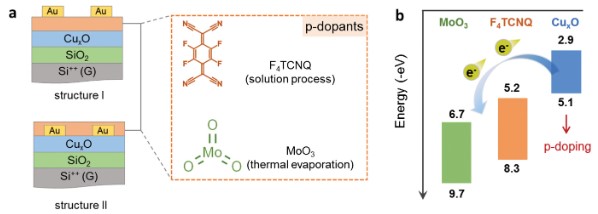Molecule Charge Transfer Doping for p‐Channel Solution‐Processed Copper Oxide Transistors
- 저자
- Ao Liu, Huihui Zhu, Yong‐Young Noh*
- 저널명
- Advanced Functional Materials, 30, 24, 2002625 (2020)
- 년도
- 2020
- Link
- https://doi.org/10.1002/adfm.202002625 201회 연결
[Abstract]
The doping of semiconductors plays a critical role in improving the performance of modern electronic devices by precisely controlling the charge carrier density. However, the absence of a stable doping method for p-type oxide semiconductors has severely restricted the development of metal oxide-based transparent p–n junctions and complementary circuits. Here, an efficient and stable doping process for p-type oxide semiconductors by using molecule charge transfer doping with tetrafluoro-tetracyanoquinodimethane (F4TCNQ) is reported. The selections of a suitable dopant and geometry play a crucial role in the charge-transfer doping effect. The insertion of a F4TCNQ thin dopant film (2–7 nm) between a Au source-drain electrode and solution-processed p-type copper oxide (CuxO) film in bottom-gate top-contact thin-film transistors (TFTs) provides a mobility enhancement of over 20-fold with the desired threshold voltage adjustment. By combining doped p-type CuxO and n-type indium gallium zinc oxide TFTs, a solution-processed transparent complementary metal-oxide semiconductor inverter is demonstrated with a high gain voltage of 50. This novel p-doping method is expected to accelerate the development of high-performance and reliable p-channel oxide transistors and has the potential for widespread applications.
